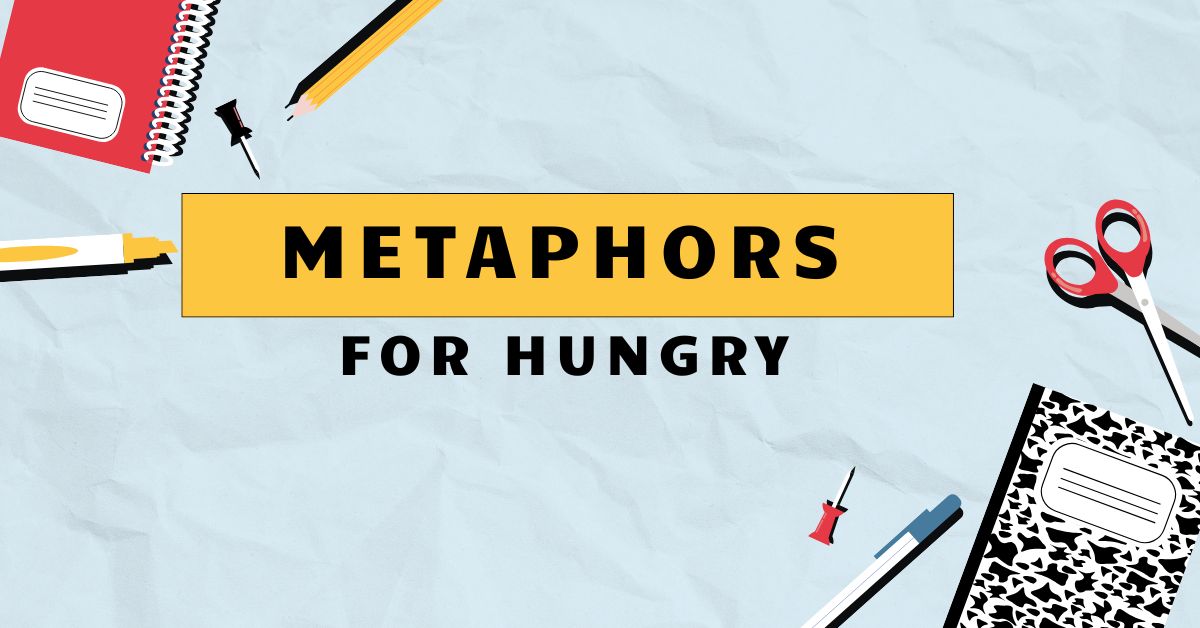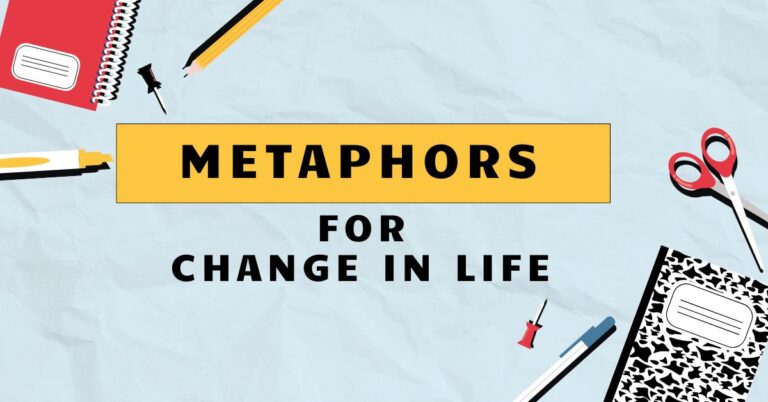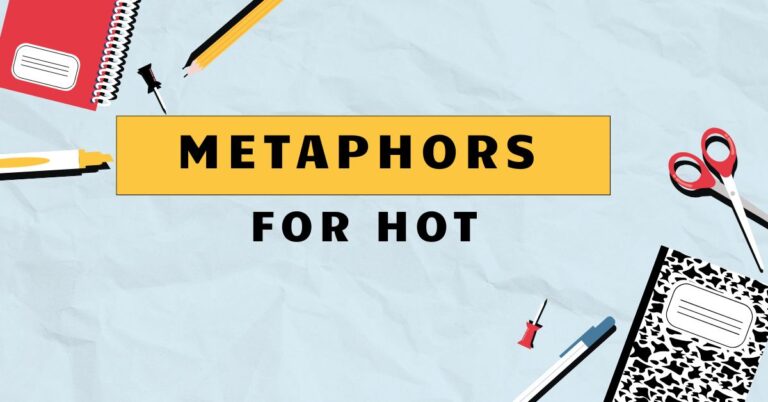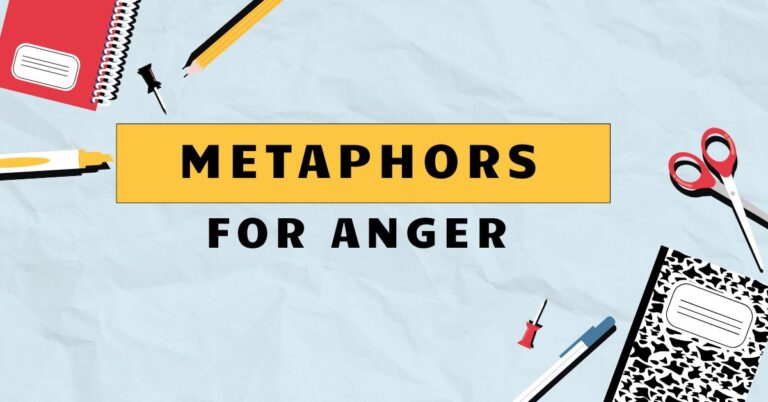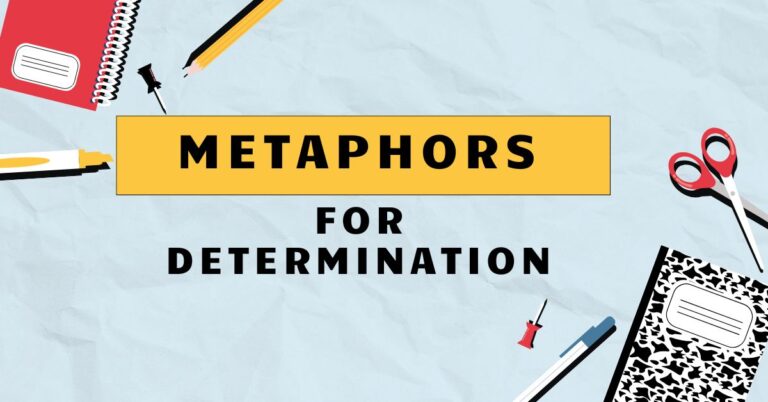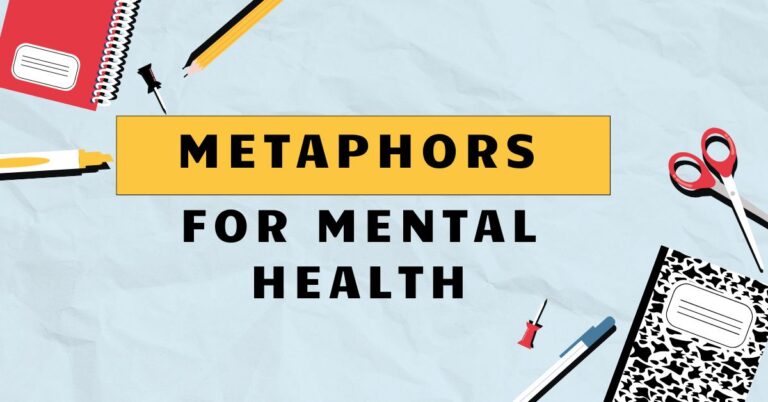37 Metaphors for Hungry: A Comprehensive Guide to Figurative Language
Understanding metaphors is crucial for mastering English, as they enrich our language and add layers of meaning to everyday expressions. When describing hunger, metaphors go beyond simply stating “I’m hungry”; they paint a vivid picture of the intensity and nature of that hunger.
This article provides an in-depth exploration of metaphors used to describe hunger, offering a variety of examples, usage rules, and practical exercises. Whether you’re an English language learner or a native speaker looking to enhance your vocabulary, this guide will equip you with the tools to express hunger in creative and impactful ways.
Table of Contents
- Introduction
- Definition of Metaphor and Hunger
- Structural Breakdown of Metaphors
- Types of Hunger Metaphors
- Examples of Metaphors for Hungry
- Usage Rules for Metaphors
- Common Mistakes When Using Hunger Metaphors
- Practice Exercises
- Advanced Topics in Metaphor Usage
- Frequently Asked Questions
- Conclusion
Definition of Metaphor and Hunger
Ametaphoris a figure of speech that directly compares two unrelated things, asserting that one thingisanother. It works by transferring qualities or attributes from one concept to another, creating a vivid and often surprising image.
Unlike similes, which use “like” or “as” to make a comparison, metaphors make a direct equation. For instance, saying “He is a lion in battle” is a metaphor, whereas “He fights like a lion” is a simile.
Hunger, in its basic sense, is the physical sensation of needing food. However, metaphorically, hunger can represent a much broader range of desires and cravings, not limited to just the physical need for sustenance.
It can symbolize a yearning for knowledge, power, love, or any other profound human desire. Understanding this duality is key to appreciating the richness of hunger metaphors.
Structural Breakdown of Metaphors
Metaphors consist of two main elements: thetenorand thevehicle. The tenor is the subject to which metaphorical attributes are ascribed.
In the context of hunger metaphors, the tenor is the feeling of hunger itself. The vehicle is the object or concept whose attributes are being transferred to the tenor.
This is the element that provides the metaphorical image and brings the comparison to life. For example, in the metaphor “I’m starving,” “I” (experiencing hunger) is the tenor, and “starving” (a state of extreme deprivation) is the vehicle.
Identifying the tenor and vehicle helps in understanding how the metaphor functions. Recognizing the shared characteristics between these two elements allows for a deeper appreciation of the intended meaning and emotional impact.
The effectiveness of a metaphor often depends on the strength and relevance of the association between the tenor and the vehicle.
Types of Hunger Metaphors
Hunger metaphors can be categorized based on the types of imagery they evoke. Here are some common categories:
Animalistic Hunger
Animalistic metaphors compare hunger to the instincts and behaviors of animals. These metaphors often highlight the primal, urgent, and sometimes aggressive nature of extreme hunger.
Words like “ravenous,” “wolfish,” and “famished” are frequently used.
Violent Hunger
Violent metaphors portray hunger as a destructive or painful force. These metaphors emphasize the intensity and discomfort of hunger, often using words like “gnawing,” “devouring,” and “consuming.” They can convey a sense of desperation and urgency.
Personification of Hunger
Personification involves giving human qualities to hunger itself. This can make hunger seem like an active agent, influencing thoughts and behaviors.
Examples include “Hunger whispered in my ear” or “Hunger drove me to the kitchen.” These metaphors add a sense of character and agency to the feeling.
Abstract Hunger
Abstract metaphors use non-physical or conceptual terms to describe hunger. These metaphors can be less direct and more evocative, often relating hunger to a lack of fulfillment or a void that needs to be filled.
For example, “I have a hunger for knowledge” or “I felt a deep emptiness in my stomach.”
Examples of Metaphors for Hungry
Here are numerous examples of metaphors for hunger, categorized by type. Each table provides a diverse range of expressions to illustrate the breadth and depth of metaphorical language used to describe hunger.
Animalistic Hunger Examples
The following table provides examples of animalistic metaphors used to describe hunger. These metaphors often emphasize the primal and instinctive nature of intense hunger.
| Metaphor | Explanation |
|---|---|
| I’m as hungry as a wolf. | Compares hunger to the intense appetite of a wolf. |
| I could eat a horse. | Exaggerates the amount of food one feels capable of consuming. |
| I’m ravenous. | Suggests an extreme, predatory hunger. |
| My stomach is growling like a bear. | Compares the sound of hunger to the growl of a bear. |
| I feel like a wild animal searching for prey. | Emphasizes the desperate and instinctive search for food. |
| I’m famished like a stray dog. | Compares hunger to the desperation of a starving stray dog. |
| My hunger is a beast inside me. | Portrays hunger as an uncontrollable animalistic force. |
| I’m peckish as a bird. | Describes a slight, bird-like hunger. |
| I’m as hungry as a hippo. | Relates hunger to the large appetite of a hippo. |
| I could devour anything in sight. | Suggests an animalistic urge to consume food rapidly. |
| I’m as hungry as a badger. | Compares hunger to the relentless foraging of a badger. |
| My hunger is roaring like a lion. | Describes the intensity of hunger as a lion’s roar. |
| I’m as hungry as a pack of wolves. | Suggests an insatiable, collective hunger. |
| I feel like a hungry hawk. | Emphasizes the sharp, focused desire for food. |
| I’m as hungry as a bear coming out of hibernation. | Compares hunger to the intense appetite after a long period of dormancy. |
| My stomach is a bottomless pit. | Suggests an endless capacity for food. |
| I’m as hungry as a shark. | Relates hunger to the predatory nature of a shark. |
| My appetite is a ravenous monster. | Portrays hunger as a destructive, consuming force. |
| I’m as hungry as a fox. | Compares hunger to the cunning and persistent search for food. |
| I feel like a scavenging hyena. | Emphasizes the desperate need to find any available food. |
| I’m as hungry as a goat. | Relates hunger to the indiscriminate eating habits of a goat. |
| My hunger is a wild dog. | Portrays hunger as an untamed, urgent desire. |
| I’m as hungry as a swarm of locusts. | Suggests an overwhelming, destructive hunger. |
| I feel like a hungry caterpillar. | Emphasizes the constant need to consume food. |
| I’m as hungry as a python. | Compares hunger to the ability to consume large quantities of food. |
Violent Hunger Examples
The following table provides examples of violent metaphors used to describe hunger. These metaphors often emphasize the painful and destructive nature of intense hunger.
| Metaphor | Explanation |
|---|---|
| My stomach is eating itself. | Suggests a destructive, self-consuming hunger. |
| Hunger is gnawing at my insides. | Portrays hunger as a painful, persistent force. |
| I feel like my stomach is a battlefield. | Emphasizes the internal struggle caused by hunger. |
| My hunger is a painful void. | Describes hunger as an aching emptiness. |
| I’m dying of hunger. | Exaggerates the severity of hunger to a life-threatening level. |
| My stomach is screaming for food. | Portrays hunger as an urgent, desperate cry. |
| Hunger is clawing at me. | Suggests a painful, aggressive feeling of hunger. |
| My insides are twisting with hunger. | Emphasizes the physical discomfort of hunger. |
| I feel like I’m being consumed by hunger. | Portrays hunger as a destructive, all-encompassing force. |
| Hunger is a blade in my gut. | Describes hunger as a sharp, painful sensation. |
| My stomach is a churning volcano. | Emphasizes the restless, eruptive feeling of hunger. |
| I feel like my body is at war with itself. | Suggests an internal conflict caused by hunger. |
| Hunger is a relentless tormentor. | Portrays hunger as a constant source of suffering. |
| My stomach is a grinding machine. | Emphasizes the relentless, uncomfortable feeling of hunger. |
| I feel like I’m being devoured from the inside out. | Portrays hunger as a destructive, internal force. |
| Hunger is a fire in my belly. | Describes hunger as a burning, intense sensation. |
| My stomach is a gaping wound. | Emphasizes the emptiness and pain of hunger. |
| I feel like I’m withering away. | Suggests a gradual decline due to lack of food. |
| Hunger is a vise grip on my stomach. | Portrays hunger as a constricting, painful sensation. |
| My stomach is a rumbling earthquake. | Emphasizes the disruptive, intense feeling of hunger. |
| I feel like my body is imploding. | Suggests an internal collapse due to lack of sustenance. |
| Hunger is a sharp sting. | Describes hunger as a sudden, painful sensation. |
| My stomach is a bottomless abyss. | Emphasizes the vast, insatiable feeling of hunger. |
| I feel like I’m being hollowed out. | Portrays hunger as a process of internal depletion. |
| Hunger is a relentless pressure. | Suggests a constant, uncomfortable sensation. |
Personification Examples
The following table provides examples of personification used to describe hunger. These metaphors give hunger human-like qualities, making it seem like an active agent.
| Metaphor | Explanation |
|---|---|
| Hunger whispered in my ear, “Eat something.” | Gives hunger the ability to speak and influence decisions. |
| Hunger drove me to the kitchen. | Portrays hunger as a force that compels action. |
| Hunger danced in my stomach. | Gives hunger a lively, active presence. |
| Hunger taunted me with the aroma of food. | Portrays hunger as a teasing, malicious entity. |
| Hunger nudged me awake in the middle of the night. | Gives hunger the ability to rouse someone from sleep. |
| Hunger demanded attention. | Portrays hunger as an insistent, demanding presence. |
| Hunger mocked me with empty cupboards. | Gives hunger a cruel, ironic nature. |
| Hunger sang a sad song in my belly. | Portrays hunger as a source of sorrow and discomfort. |
| Hunger conspired with my cravings. | Gives hunger the ability to plot and scheme. |
| Hunger pushed me towards the vending machine. | Portrays hunger as a guiding, compelling force. |
| Hunger played tricks on my mind. | Gives hunger the ability to deceive and manipulate. |
| Hunger pleaded for a sandwich. | Portrays hunger as a desperate, begging entity. |
| Hunger marched through my body. | Gives hunger a strong, assertive presence. |
| Hunger scolded me for skipping breakfast. | Portrays hunger as a disapproving, reprimanding force. |
| Hunger celebrated when I finally ate. | Gives hunger the ability to feel joy and satisfaction. |
| Hunger judged my healthy snack choices. | Portrays hunger as a critical, discerning entity. |
| Hunger sulked when I resisted temptation. | Gives hunger the ability to feel disappointment and resentment. |
| Hunger whispered sweet nothings about pizza. | Portrays hunger as a seductive, persuasive force. |
| Hunger plotted its next attack. | Gives hunger the ability to plan and strategize. |
| Hunger pestered me all afternoon. | Portrays hunger as a persistent, annoying presence. |
| Hunger reminded me of my empty refrigerator. | Gives hunger the ability to remind and nag. |
| Hunger smiled when I opened the cookie jar. | Portrays hunger as a pleased, anticipatory entity. |
| Hunger dreamt of a feast. | Gives hunger the ability to dream and imagine. |
| Hunger urged me to order takeout. | Portrays hunger as an insistent, persuasive force. |
| Hunger sighed with relief after the meal. | Gives hunger the ability to feel contentment and ease. |
Abstract Hunger Examples
The following table provides examples of abstract metaphors used to describe hunger. These metaphors relate hunger to non-physical concepts like emptiness, desire, or lack of fulfillment.
| Metaphor | Explanation |
|---|---|
| I have a hunger for knowledge. | Relates hunger to a strong desire for learning. |
| I felt a deep emptiness in my stomach. | Describes hunger as a void or lack of substance. |
| My hunger is a bottomless pit of need. | Portrays hunger as an insatiable, never-ending desire. |
| I have a craving for adventure. | Relates hunger to a yearning for new experiences. |
| My soul feels hungry. | Describes a deep, spiritual longing. |
| I felt an aching void inside me. | Emphasizes the painful emptiness of hunger. |
| My hunger is a thirst for something more. | Relates hunger to a desire for greater fulfillment. |
| I felt a gnawing sense of incompleteness. | Describes hunger as a feeling of being unfinished or lacking. |
| My hunger is a longing for connection. | Relates hunger to a desire for social interaction. |
| I felt an emptiness that only food could fill. | Emphasizes the specific role of food in satisfying hunger. |
| My hunger is a void in my heart. | Relates hunger to a deep emotional need. |
| I felt a hollow echo in my stomach. | Describes hunger as an empty, resonant feeling. |
| My hunger is a yearning for comfort. | Relates hunger to a desire for emotional solace. |
| I felt a profound sense of deprivation. | Emphasizes the feeling of being without something essential. |
| My hunger is a quest for satisfaction. | Relates hunger to a search for fulfillment. |
| I felt an absence that only a good meal could address. | Emphasizes the specific role of food in alleviating hunger. |
| My hunger is a shadow over my thoughts. | Relates hunger to a pervasive, influencing presence. |
| I felt an unfilled space inside me. | Describes hunger as an unoccupied area within oneself. |
| My hunger is a search for wholeness. | Relates hunger to a desire for completeness. |
| I felt a deficiency that only nourishment could resolve. | Emphasizes the specific role of nourishment in resolving hunger. |
| My hunger is a silent scream. | Relates hunger to an unspoken, intense need. |
| I felt an unfulfilled potential. | Describes hunger as a lack of realized possibilities. |
| My hunger is a bridge to satisfaction. | Relates hunger to a pathway towards contentment. |
| I felt an incomplete puzzle within me. | Describes hunger as a missing piece in one’s life. |
| My hunger is a whisper of need. | Relates hunger to a subtle, underlying desire. |
Usage Rules for Metaphors
While metaphors enrich language, using them effectively requires understanding certain rules:
- Clarity: Ensure the comparison is understandable. Avoid metaphors that are too obscure or confusing.
- Relevance: The vehicle should have a clear connection to the tenor. The shared characteristics should be apparent.
- Originality: Strive for fresh and creative metaphors. Overused metaphors can become clichés and lose their impact.
- Consistency: Maintain consistency within a metaphor. Avoid mixing unrelated images or ideas.
- Context: Consider the context and audience. Metaphors should be appropriate for the situation and the reader’s understanding.
For example, saying “My hunger is a roaring engine” is effective because it clearly conveys the powerful and insistent nature of hunger. However, “My hunger is a purple elephant” is confusing because the connection between hunger and a purple elephant is unclear and arbitrary.
Common Mistakes When Using Hunger Metaphors
Here are some common mistakes to avoid when using metaphors for hunger:
| Incorrect | Correct | Explanation |
|---|---|---|
| I’m hungry like a house. | I’m as hungry as a horse. | The comparison to a house doesn’t make sense; a horse is commonly associated with a large appetite. |
| My stomach is singing loudly, so I’m full. | My stomach is growling loudly, so I’m hungry. | Singing is not typically associated with hunger; growling is a common sound indicating hunger. |
| Hunger is a green thought. | Hunger is a gnawing feeling. | “Green thought” is an abstract and unclear comparison; “gnawing feeling” directly relates to the discomfort of hunger. |
| I feel like eating a star. | I feel like eating the entire galaxy. | Eating a star is not a common expression for intense hunger. Suggesting eating a galaxy would more accurately exaggerate the amount of food one feels capable of consuming. |
| My hunger is a peaceful ocean. | My hunger is a raging storm. | A peaceful ocean does not convey the urgency and discomfort of hunger; a raging storm better emphasizes the chaotic and intense feeling. |
Practice Exercises
Test your understanding of hunger metaphors with these exercises.
Exercise 1: Identify the Metaphor
Identify the metaphor in each sentence.
| Question | Answer |
|---|---|
| 1. My stomach is a rumbling volcano. | rumbling volcano |
| 2. Hunger whispered in my ear to eat something. | Hunger whispered in my ear |
| 3. I’m as hungry as a wolf. | as hungry as a wolf |
| 4. Hunger is gnawing at my insides. | gnawing at my insides |
| 5. I felt a deep emptiness in my stomach. | a deep emptiness |
| 6. Hunger drove me to the kitchen. | Hunger drove me |
| 7. I could eat a horse. | eat a horse |
| 8. My hunger is a fire in my belly. | a fire in my belly |
| 9. I’m dying of hunger. | dying of hunger |
| 10. I have a hunger for knowledge. | a hunger for knowledge |
Exercise 2: Complete the Metaphor
Complete the following sentences with an appropriate metaphor for hunger.
| Question | Answer |
|---|---|
| 1. I’m so hungry, I could _____. | eat a bear |
| 2. My stomach feels like _____. | a bottomless pit |
| 3. Hunger is _____ at me. | clawing |
| 4. I have a _____ for adventure. | craving |
| 5. My appetite is a _____ monster. | ravenous |
| 6. Hunger is _____ in my belly. | roaring |
| 7. I feel like my body is _____ itself. | eating |
| 8. My soul feels _____. | hungry |
| 9. I’m as famished as a _____. | stray dog |
| 10. Hunger is a _____ tormentor. | relentless |
Exercise 3: Create Your Own Metaphor
Create your own original metaphor for hunger.
Example Answer: My hunger is a persistent shadow, always lurking just behind my thoughts.
Advanced Topics in Metaphor Usage
For advanced learners, exploring the nuances of extended metaphors and mixed metaphors can enhance metaphorical proficiency. Anextended metaphoris a metaphor that is developed over several lines or even an entire piece of writing.
This allows for a more complex and nuanced comparison.
Amixed metaphoris a combination of two or more incompatible metaphors in a single expression. While sometimes used for comedic effect, mixed metaphors often create confusion and should generally be avoided.
For example, “Let’s nip it in the bud before it snowballs” combines two unrelated images (nipping a bud and a snowball rolling), creating a nonsensical image.
Analyzing literary works and speeches for their use of metaphors can further refine understanding and appreciation of this powerful figure of speech. Pay attention to how skilled writers use metaphors to convey complex ideas, evoke emotions, and create vivid imagery.
Frequently Asked Questions
Here are some frequently asked questions about metaphors for hunger:
- What is the difference between a metaphor and a simile?
A metaphor directly compares two things by stating that one thing is another, while a simile uses “like” or “as” to make a comparison. For example, “He is a lion” (metaphor) vs. “He is like a lion” (simile).
- Why are metaphors important in language?
Metaphors add depth, color, and creativity to language. They allow us to express complex ideas in a more vivid and engaging way, making our communication more impactful and memorable.
- How can I improve my ability to understand and use metaphors?
Read widely, pay attention to how metaphors are used in literature and everyday conversation, and practice creating your own metaphors. Analyzing the structure and meaning of existing metaphors can also be helpful.
- Are some metaphors better than others?
Yes. Effective metaphors are clear, relevant, original, and consistent. They should create a strong and understandable connection between the tenor and the vehicle.
- What is a dead metaphor?
A dead metaphor is a metaphor that has become so overused that it has lost its figurative meaning and is now used literally. Examples include “the leg of a table” or “the heart of the matter.”
- How do cultural differences affect the interpretation of metaphors?
Cultural background can significantly influence the interpretation of metaphors. Some metaphors may be culturally specific and not easily understood by people from different cultures. Awareness of these differences is crucial for effective cross-cultural communication.
- Can metaphors be used in formal writing?
Yes, but sparingly and with careful consideration. Metaphors can add impact and clarity to formal writing, but they should be used judiciously and appropriately for the audience and context.
- What are some common sources of metaphorical imagery?
Common sources include nature (e.g., “a sea of troubles”), animals (e.g., “as sly as a fox”), and human experiences (e.g., “a mountain of paperwork”).
- How can I avoid using clichés when creating metaphors?
Strive for originality by thinking outside the box and exploring unconventional comparisons. Consider the specific qualities you want to emphasize and brainstorm unique images that capture those qualities.
- Is it possible to overuse metaphors?
Yes. Overusing metaphors can make your writing seem contrived or confusing. Use them strategically and purposefully to enhance your message, not to overwhelm it.
Conclusion
Mastering metaphors for hunger, and metaphors in general, significantly enhances your ability to express yourself creatively and effectively in English. By understanding the different types of metaphors, their structural elements, and the rules governing their usage, you can add depth and richness to your language.
Remember to practice regularly, analyze examples from various sources, and strive for clarity, relevance, and originality in your metaphorical expressions. With consistent effort, you’ll be able to paint vivid pictures with your words and communicate your thoughts and feelings with greater precision and impact.

